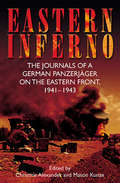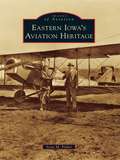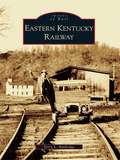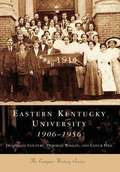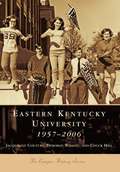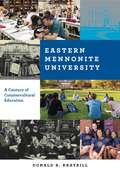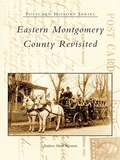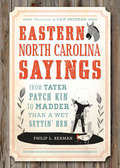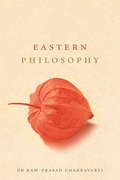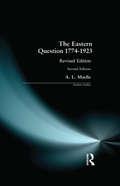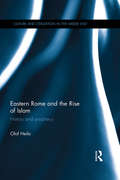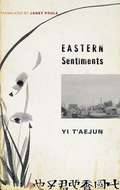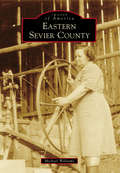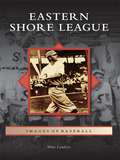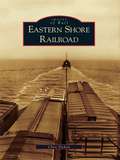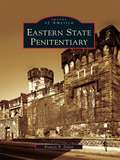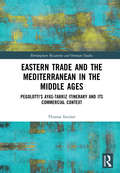- Table View
- List View
Eastern Inferno: The Journals of a German Panzerjäger on the Eastern Front, 1941–43
by Hans Roth&“Remarkable personal journals . . revealing the combat experience of the German-Russian War as seldom seen before . . . a harrowing yet poignant story&” (Military Times). Hans Roth was a member of the anti-tank panzerjager battalion, 299th Infantry Division, attached to the Sixth Army, as the invasion of Russia began. As events transpired, he recorded the tension as the Germans deployed on the Soviet frontier in June 1941. Then, a firestorm broke loose as the Wehrmacht tore across the front, forging into the primitive vastness of the East. During the Kiev encirclement, Roth&’s unit was under constant attack as the Soviets desperately tried to break through the German ring. At one point, after the enemy had finally been beaten, a friend serving with the SS led him to a site—possibly Babi Yar—where he witnessed civilians being massacred. After suffering through a brutal winter against apparently endless Russian reserves, his division went on the offensive again when the Germans drove toward Stalingrad. In these journals, attacks and counterattacks are described in you-are-there detail. Roth wrote privately, as if to keep himself sane, knowing his honest accounts of the horrors in the East could never pass Wehrmacht censors. When the Soviet counteroffensive of winter 1942 begins, his unit is stationed alongside the Italian 8th Army, and his observations of its collapse, as opposed to the reaction of the German troops sent to stiffen its front, are of special fascination. Roth&’s three journals were discovered many years after his disappearance, tucked away in the home of his brother. After his brother&’s death, his family discovered them and sent them to Rosel, Roth&’s wife. In time, Rosel handed down the journals to Erika, Roth&’s only daughter, who had emigrated to America. Roth was likely working on a fourth journal before he was reported missing in action in July 1944. Although his ultimate fate remains unknown, what he did leave behind, now finally revealed, is an incredible firsthand account of the horrific war the Germans waged in Russia.
Eastern Iowa's Aviation Heritage (Images of Aviation)
by Scott M. FisherIowans embraced aviation from its very beginning. In the late 1800s, Keokuk's Baldwin brothers headlined Lee County Chautauqua festivals with balloon ascensions. Two decades later, early powered-flight daredevils like Lincoln Beachey, Glenn Messer, and Eugene Ely thrilled huge crowds along the Mississippi River from Decorah to Fort Madison. Dubuque's Clifton "Ole" Oleson barnstormed from Oelwein to Mount Pleasant and in communities in between. Visionaries like the Livingston brothers from Cedar Falls and Davenport's Ralph Cram, Don Luscombe, and Billy Cook started air taxi and freight lines, flight and mechanic schools, and aircraft manufacturing facilities. Iowa City became an original U.S. Airmail stop and, during World War II, Ottumwa and other communities operated training sites for military aviation, with women playing a major role. The postwar establishment of regional air carriers became commonplace, and today a new generation is leading Eastern Iowa into the 21st century while preserving the memory of those who started it all.
Eastern Kentucky Railway
by Terry L. BaldridgeIn 1865, as the Civil War was drawing to a close, plans were underway in Boston for a railroad construction project to begin in Greenup County, Kentucky. Eventually the Eastern Kentucky Railway Company would extend its main track through two more counties, Carter and Lawrence. Spanning just 36 miles of main track from Riverton to Webbville, theEastern Kentucky Railway became a lifeline for the economic and social activities of the people of northeastern Kentucky. Even though the original plan of extending the railway much farther south and bridging the Ohio River to the north never came about, the railway struggled along for more than 65years. Many people who grew up along the line passed their experiences to younger generations; some, like Jesse Stuart, wrote about them. This volume will show life along the rail line that lent its name to the highways now running its route.
Eastern Kentucky University, 1906-1956 (The Campus History Series)
by Deborah Whalen Chuck Hill Jacqueline CoutureLocated in Richmond, Kentucky, Eastern Kentucky University has a distinguished record of 100 years of educational service to the commonwealth. Founded in 1906 as a normal school, Eastern evolved into a teachers college, then a state college, and finally a university. As EKU serves the Eastern Kentucky region, it is becoming an institution of national distinction, well known as a comprehensive public university dedicated to high quality instruction, service, and scholarship. This volume covers the first 50 years of a regional college that, at first, focused on educating teachers for the classroom, aided by the establishment of a model training school. The mission soon expanded to include programs such as business, home economics, music, and industrial arts. "Eastern Kentucky University" illustrates the university's emergence through over 200 images from the EKU Archives that capture the "Campus Beautiful," athletic competition, teacher training, academics, and student life.
Eastern Kentucky University, 1957-2006 (The Campus History Series)
by Deborah Whalen Chuck Hill Jacqueline CoutureFrom its inception as a normal school in 1906, Eastern Kentucky University has provided a century of educational opportunity and has risen to meet the changing needs of students across the commonwealth. Dedicated to high-quality instruction, service, and scholarship, Eastern is a student-centered comprehensive public university located in Richmond, Kentucky. This volume covers the second 50 years of a regional university that has gradually shifted focus from teacher education to a more expanded curriculum including public health, law enforcement, and business, as well as the traditional liberal arts. Eastern Kentucky University: 19572006 illustrates the university's growth through more than 200 images from the Eastern Kentucky University Archives that capture the building of a university, athletic competition, academics, and student life.
Eastern Mediterranean Port Cities: A Study Of Mersin, Turkey-from Antiquity To Modernity (The Urban Book Series)
by Filiz Yenişehirlioğlu Eyüp Özveren Tülin Selvi ÜnlüThis book surveys the historical development, current problems and likely prospects for Eastern Mediterranean port cities, providing contributions from scholars from various disciplines, such as archaeologists, historians, economists, urban planners and architects. By studying the city of Mersin and the surrounding area, it offers insights into the changing nature of Eastern Mediterranean port cities.The first part of the book discusses the approaches to the Mediterranean World, from the late prehistory to the present, and questions the implications of the values inherited from the past for a sustainable future. The second part then examines the social structure of Eastern Mediterranean port cities presenting an in-depth study of different ethnic groups and communities. In the third part the changing physical structure of these cities is elucidated from the perspectives of archaeology, architecture, and urban planning. The last part focuses on urban memory through a detailed study based on live recordings of original accounts by the local people. The book benefits prospective researchers in the field of Mediterranean studies, archaeology, history, economic history, architecture and urban planning.
Eastern Mennonite University: A Century of Countercultural Education
by Donald B. KraybillIn this unique educational history, Donald B. Kraybill traces the sociocultural transformation of Eastern Mennonite University from a fledgling separatist school founded by white, rural, Germanic Mennonites into a world-engaged institution populated by many faith traditions, cultures, and nationalities.The founding of Eastern Mennonite School, later Eastern Mennonite University, in 1917 came at a pivotal time for the Mennonite community. Industrialization and scientific discovery were rapidly changing the world, and the increasing availability of secular education offered tempting alternatives that threatened the Mennonite way of life. In response, the Eastern Mennonites founded a school that would “uphold the principles of plainness and simplicity,” where youth could learn the Bible and develop skills that would help advance the church. In the latter half of the twentieth century, the university’s identity evolved from separatism to social engagement in the face of churning moral tides and accelerating technology. EMU now defines its mission in terms of service, peacebuilding, and community.Comprehensive and well told by a leading scholar of Anabaptist and Pietist studies, this social history of Eastern Mennonite University reveals how the school has mediated modernity while remaining consistently Mennonite. A must-have for anyone affiliated with EMU, it will appeal especially to sociologists and historians of Anabaptist and Pietist studies and higher education.
Eastern Mennonite University: A Century of Countercultural Education
by Donald B. KraybillIn this unique educational history, Donald B. Kraybill traces the sociocultural transformation of Eastern Mennonite University from a fledgling separatist school founded by white, rural, Germanic Mennonites into a world-engaged institution populated by many faith traditions, cultures, and nationalities.The founding of Eastern Mennonite School, later Eastern Mennonite University, in 1917 came at a pivotal time for the Mennonite community. Industrialization and scientific discovery were rapidly changing the world, and the increasing availability of secular education offered tempting alternatives that threatened the Mennonite way of life. In response, the Eastern Mennonites founded a school that would “uphold the principles of plainness and simplicity,” where youth could learn the Bible and develop skills that would help advance the church. In the latter half of the twentieth century, the university’s identity evolved from separatism to social engagement in the face of churning moral tides and accelerating technology. EMU now defines its mission in terms of service, peacebuilding, and community.Comprehensive and well told by a leading scholar of Anabaptist and Pietist studies, this social history of Eastern Mennonite University reveals how the school has mediated modernity while remaining consistently Mennonite. A must-have for anyone affiliated with EMU, it will appeal especially to sociologists and historians of Anabaptist and Pietist studies and higher education.
Eastern Montgomery County Revisited
by Andrew Mark HermanMontgomery County was incorporated in 1784, though much of the area was settled in the late 1600s and early 1700s through land grants by Pennsylvania's founder, William Penn. Located immediately northwest of Philadelphia, the Quaker city has always influenced the county. Wealthy mansions, religious institutions, colleges, and industry all have contributed to the fabric of the county. Eastern Montgomery County Revisited explores this scenic and historic area with rare postcards from 1905 to 1970 and is meant to be a companion to Eastern Montgomery County. Although this book visits many favorite and familiar parts of the county, great emphasis has been placed on smaller, lesser-known places that truly make this book intriguing and unique.
Eastern North Carolina Farming
by Frank Stephenson Barbara Nichols MulderSettled as a maritime and agricultural colony, North Carolina's history has always been intertwined with agriculture and farming. After the Civil War, North Carolina became the nation's top grower of tobacco, and one of the country's largest tobacco companies--the American Tobacco Company--flourished from the huge quantities of Eastern North Carolina-grown tobacco that was purchased. With the growing success of cotton farming and other crops and livestock--including corn, peanuts, and hogs--the region was particularly rich in subsistence farming. Over the course of the 20th century, farming and agriculture went through tremendous change. The familiar landscape of cotton and tobacco began to shift and include more varied crops, such as soybeans and sweet potatoes. At the same time, hand tools were exchanged for tractors and combines. Eastern North Carolina Farming showcases the rich history of this agriculturally dynamic region while telling the individual stories of farmers who grew for families, markets, and distribution.
Eastern North Carolina Sayings: From Tater Patch Kin to Madder Than A Wet Settin' Hen (True Crime)
by Cait Brennan Philip L. BeamanGrowing up on a farm in the heart of eastern North Carolina's tobacco country, author Phil Beaman has been surrounded by country folk and their colorful language his entire life. Though these communities continue to change, the bond of their phrases, expressions, colloquialisms and just plain talk has remained within the hearts and minds of their people. Beaman chronicles this language in a humorous and fascinating collection of eastern North Carolina's most down-home sayings. Everything from the weather to drunken sayings to gobbledygook is presented straight from the horse's mouth. You may not know how to pronounce some of the words, but you will surely enjoy a trip back to the halcyon days of livin' off the land and chewin' the fat..
Eastern Orthodox Christianity: The Essential Texts
by Theofanis G. Stavrou Bryn GeffertTwo leading academic scholars offer the first comprehensive source reader on the Eastern Orthodox church for the English-speaking world. Designed specifically for students and accessible to readers with little or no previous knowledge of theology or religious history, this essential, one-of-a-kind work frames, explores, and interprets Eastern Orthodoxy through the use of primary sources and documents. Lively introductions and short narratives that touch on anthropology, art, law, literature, music, politics, women's studies, and a host of other areas are woven together to provide a coherent and fascinating history of the Eastern Orthodox Christian tradition.
Eastern Philosophy
by Chakravarthi Ram-PrasadA magisterial overview of the philosophies of the East.'The time has come for global philosophy to move beyond the model where the West is at the centre of radiating spokes of comparison.' Challenging the notion that Western philosophy is the best or only yardstick against which to judge the so-called 'non-Western' philosophies, Chakravarthi Ram-Prasad sets up a lively debate in which the great thought systems of the East are engaged very much in their own terms. The author's impressive sweep takes him through South Asia east to China and Japan, encompassing 3000 years of philosophy and including the ancient philosophies of India, Jainism, Buddhism, Daoism and Confucianism. At the same time, Ram-Prasad dispels the romantic illusion that there is some common mystical 'wisdom tradition' that binds together the cultures of the East. His aim is to give a sense of the diversity and depth of these philosophical cultures, as well as their sophistication and originality; and to make comparisons between them to illuminate their varied yet potentially universal appeal.
Eastern Question 1774-1923, The: Revised Edition (Seminar Studies)
by Alexander Lyon MacfieA clear and concise guide to the Eastern Question - the problem facing the European states of how to react to the decline of the Ottoman Empire. A L MacFie's study shows how the question was a major factor in shaping the policies of all the major powers from the Russo-Turkish War of 1768-74 down to the Treaty of Lausanne in 1923.
Eastern Resonances in Early Modern England: Receptions and Transformations from the Renaissance to the Romantic Period (New Transculturalisms, 1400–1800)
by Ladan Niayesh Claire GallienThe concept of resonance collapses the binary between subject and object, perceiver and perceived, evoking a sound or image that is prolonged and augmented by making contact with another surface. This collection uses resonance as an innovative framework for understanding the circulation of people and objects between England and its multiple Asian Easts. Moving beyond Saidian Orientalism to engage with ongoing critical conversations in the fields of connected history, material culture, and thing theory, it offers a vibrant range of case studies that consider how meanings accrue and shift through circulation and interconnection from the sixteenth to the early nineteenth century. Spanning centuries of traveling translations, narratives, myths, practices, and other cultural phenomena, Eastern Resonances in Early Modern England puts forth resonance not just as a metaphor, but a mode of investigation.
Eastern Rome and the Rise of Islam: History and Prophecy (Culture and Civilization in the Middle East)
by Olof HeiloThe emergence of Islam in the seventh century AD still polarises scholars who seek to separate religious truth from the historical reality with which it is associated. However, history and prophecy are not solely defined by positive evidence or apocalyptic truth, but by human subjects, who consider them to convey distinct messages and in turn make these messages meaningful to others. These messages are mutually interdependent, and analysed together provide new insights into history. It is by way of this concept that Olof Heilo presents the decline of the Eastern Roman Empire as a key to understanding the rise of Islam; two historical processes often perceived as distinct from one another. Eastern Rome and the Rise of Islam highlights significant convergences between Early Islam and the Late Ancient world. It suggests that Islam's rise is a feature of a common process during which tensions between imperial ambitions and apocalyptic beliefs in Europe and the Middle East cut straight across today's theological and political definitions. The conquests of Islam, the emergence of the caliphate, and the transformation of the Roman and Christian world are approached from both prophetic anticipations in the Ancient and Late Ancient world, and from the Medieval and Modern receptions of history. In the shadow of their narratives it becomes possible to trace the outline of a shared history of Christianity and Islam. The "Dark Ages" thus emerge not merely as a tale of sound and fury, but as an era of openness, diversity and unexpected possibilities. Approaching the rise of Islam as a historical phenomenon, this book opens new perspectives in the study of early religion and philosophy, as well as providing a valuable resource for students and scholars of Islamic Studies.
Eastern Sentiments
by Janet Poole Yi T'AejunIt is believed Yi T'aejun passed away between 1960 and 1980, but his works were not made available until 1988, when South Korean censorship laws concerning authors who had sided with the north were eased. The essays in this collection reflect Yi's distinct voice and lyrical expression, revealing thoughts on a variety of subjects, from gardens to immigrant villages in Manchuria, from antiques to colonial assimilation, and from fishing to the recovery of Korea's past.
Eastern Sentiments (Weatherhead Books on Asia)
by T'aejun YiThe Confucian gentleman scholars of the Choson dynasty (1392-1910) often published short anecdotes exemplifying their values and aesthetic concerns. In modern Seoul one scholar in particular would excel at adapting this style to a contemporary readership: Yi T'aejun.Yi T'aejun was a prolific and influential writer of colonial Korea and an acknowledged master of the short story and essay. He also wrote numerous novels and was an influential editor of cultural news. Born in northern Korea in 1904, Yi T'aejun settled in Seoul after a restless youth that included several years of study in Japan. In 1946, he moved to Soviet-occupied northern Korea, but by 1956, a purge of southern communists forced him into exile. His subsequent whereabouts cannot be confirmed, though rumors claim Yi returned to Pyongyang, only to be exiled once more. It is believed Yi T'aejun passed away between 1960 and 1980, but his works were not made available until 1988, when South Korean censorship laws concerning authors who had sided with the north were eased. The essays in this collection reflect Yi's distinct voice and lyrical expression, revealing thoughts on a variety of subjects, from gardens to immigrant villages in Manchuria, from antiques to colonial assimilation, and from fishing to the recovery of Korea's past. Yi laments the passing of tradition with keen sensibility yet, at the same time, celebrates human perseverance in the face of loss and change. Most important, his essays recount the author's attempt to re-experience the past and keep it alive against absorption into the Japanese nation. Janet Poole faithfully reproduces Yi's complex craft, retaining his idiosyncratic tone and narrative. A brilliant introduction to a remarkable prose stylist, Eastern Sentiments eloquently complicates the historical, political, and aesthetic concerns of Orientalism.
Eastern Sevier County (Images of America)
by Michael WilliamsEastern Sevier County rests in the foothills of the Great Smoky Mountains National Park. The area is home to the small communities of Foxfire Mountain, Pittman Center, Jones Cove, Richardson's Cove, Locust Ridge, and Pearl Valley. Foxfire Mountain is best known today for the adventure park and agri-tourist destination brought to life by the Postlewaite family, yet it also boasts a colorful history that includes Benjamin Owens, a judge notorious for hanging convicts from an oak tree on his property. Locust Ridge is the birthplace of country music legend Dolly Parton, and it has been reported that her father compensated the attending physician who delivered Dolly with a bag of cornmeal. Pittman Center, originally a Cherokee hunting ground, is now the largest community in this portion of the county. Strangely, the town is named for Dr. Eli Pittman of New York, who assisted local minister John Burnett with fundraising to build a school to serve the area. Pittman Center is now a favorite destination for those enjoying the Great Smoky Mountains National Park.
Eastern Shore Beer: The Heady History of Chesapeake Brewing (American Palate)
by Doug Griffith Tony RussoWhen Great Britain levied heavy taxes against the colonies, the Eastern Shore's first beer geek, John Beale Bordley, swore off English ales and set his substantial estate to perfecting his own home brews. It took another two centuries and a revolution of a different kind to bring brewing back to the Maryland shore. In 1989, Wild Goose bore the gospel of drinking local to Cambridge before falling victim to the first craft beer bubble. The next wave of high-gravity harbingers like Eastern Shore Brewing, Burley Oak and Evolution Craft Brewing fought to change collective palates and legislation allowing them to serve up their frosty pints. Beer bard and blogger Tony Russo taps into this full-bodied history while introducing the region's bold new batch of brewers.
Eastern Shore League (Images of Baseball)
by Mike LambertBetween 1922 and 1949, the citizens of Delmarva enjoyed watching baseball the way it was meant to be played. Loyal Eastern Shore baseball enthusiasts were blessed to witness three eras of professional class "D" baseball, supporting their favorite teams, including the Parksley Spuds, Salisbury Indians, and Dover Orioles. The local faithful cheered on homegrown legends such as Frank "Home Run" Baker and Jimmie Foxx, both destined for enshrinement in the National Baseball Hall of Fame in Cooperstown, New York.
Eastern Shore Railroad
by Chris DickonIn the 1880s, New York railroad magnate Alexander Cassatt looked at a map of America's East Coast and decided that he could overcome a challenge of geography if he thought of a new railroad in a non-traditional way. North and South were now trading with each other postwar, and the two mostprominent coastal cities of those regions, New York and Norfolk, were less than 500 miles apart--except for one very large problem: at the end of a straight route down the Eastern Shore of Virginia lay the mouth of the Chesapeake Bay, with more than 20 miles of open water to the rail yardsof Norfolk. Thus Cassatt created the New York, Philadelphia, & Norfolk Railroad, which ran overland from Philadelphia to Cape Charles, Virginia; at Cape Charles, the railroad became waterborne on barges and passengerferries that traveled the rough waters at the mouth of the bay. Now known as the Eastern Shore Railroad, since 1884, the operation has followed a path through history that has been no less dramatic than the rise and fall--and curves in the rightof-way--of American railroading during that time.
Eastern State Penitentiary (Images of America)
by Francis X. DolanThe most significant building project of its time, Eastern State Penitentiary was designed to reshape the mind of an inmate, rather than punish the body of one. It was believed that by keeping prisoners isolated in the chapel-like cells the inner light of their souls would emerge, leading them to discover penitence. In reality, the isolation was nearly impossible to maintain, and the lofty goals of thefounders crumbled in the 20th century, much like the building itself. Originally located on the outskirts of Philadelphia, the city eventually expanded and swallowed up the prison. Its unique location becameproblematic, and numerous escapes and riots threatened the civilian populace in the area. The prison was home to such well-known figures as Chicago mob boss Al Capone and bank robber Willie Sutton, once the most wanted man in America. Eastern State Penitentiary chronicles the history of this massive prison from its opening in 1829 to its closing and abandonment in 1971, and finally to the rebirth of the prison in the 1990s as a thriving historic site and national historic landmark.
Eastern Trade and the Mediterranean in the Middle Ages: Pegolotti’s Ayas-Tabriz Itinerary and its Commercial Context (Birmingham Byzantine and Ottoman Studies #25)
by Thomas SinclairAt the end of the High Middle Ages in Europe, with buying power and economic sophistication at a high, an itinerary detailing the toll stations along a commercial artery carrying eastern goods (from China, India and Iran) towards Europe was compiled, and later incorporated in the well-known trading manual of the Florentine bank official Pegolotti; Pegolotti was twice stationed in the city of Famagusta in Cyprus, which lay opposite the city of Ayas where the land route ended. The Il-Khanid capital, Tabriz in Iran, attracting expensive merchandise such as spices and silk from a variety of origins, was the road’s starting-point. To demonstrate the importance of the route in its own time, parallel and contemporary routes in the Black Sea and the Levant are traced and the effect of trade on their cities noted. To compare the Ayas itinerary (1250s to 1330s) with previous periods the networks of commercial avenues in the previous period (1100-1250) and the subsequent one (1340s to 1500) are reconstructed. In each period the connection of east-west trade with the main movements of the European economy are fully drawn out, and the effects on the building history of the three main Italian cities concerned (Venice, Genoa and Florence) are sketched. Attention then turns to the Pegolotti itinerary itself. The individual toll stations are identified employing a variety of means, such as names taken from the Roman itineraries (Peutinger Table and Antonine Itinerary) and archaeological data; this allows the course of the track to be followed through diverse topography to the city of Sivas, then across plains and through passes to Erzurum and finally to Tabriz. A picture is drawn of the urban history of each major city, including Sivas, Erzurum and Tabriz itself, and of the other towns along the route.
Eastern Turkey: An Architectural and Archaeological Survey, Volume I
by T A SinclairCivilizations of great diversity have succeeded each other or co-existed in Eastern Turkey, and most of them have left monuments of high quality. Hittite, Urartian, Hellenistic, Roman, Syrian, Byzantine, Armenian, Arab, Seljuk and Ottoman, their remains are all represented in the region. These include some of the most important sites in Near Eastern archaeology, in regions in and near the heartland of the Hittite and Urartian cultures. The Hellenistic cities reflect the introduction of a new civilization, and the Roman and Byzantine empires included all or part of the region, with the prosperous feudal states of Georgia and Armenia on their borders. Besides the Byzantine, three great East Christian monastic traditions, Syrian, Georgian and Armenian, flourished here from the late fourth century onwards, and their monuments have left a permanent mark on the landscape. The Seljuk invasion, followed by the more recent period of Ottoman rule, led to the imposition of a new culture on the region, and its reflection in the monuments. Some of the finest Seljuk buildings are in Eastern Turkey, and the buildings of the Turkish states east of the Seljuk empire form much of the early history of Turkish architecture. The independent Greek empire of Trebizond and two of the four Crusader states lay in Eastern Turkey. The lands of the empires and the smaller medieval states were heavily fortified, and their castles and other fortifications are now spread over the region. The cultural diversity of its inheritance has made Eastern Turkey one of the most fascinating regions for archaeological and art-historical research. These four volumes provide the first comprehensive guide to all of the important historical sites of the region, the result of eight years of travel and research. The monuments are dealt with by geographical location, including a full description of each site, and details on how it can be reached. In the case of the more important monuments, a full bibliography of earlier work is provided. The ample provision of photographs and plans enhances the value of the author's detailed descriptions.
